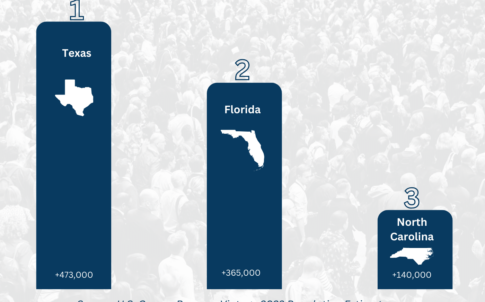North Carolina’s Strong Population Growth Continues

Dr. Michael Cline is the state demographer for North Carolina at the Office of State Budget and Management and has given us permission to re-post his content here. The original version of this piece is here.
Once again, North Carolina added more people in the last year than any other state except Texas and Florida. According to the US Census Bureau’s latest population estimates, an additional 140,000 people were added to the permanent resident population of North Carolina between July 1, 2022 and July 1, 2023. Since the last decennial count (April 1, 2020), there have been 396,000 people added to North Carolina’s population. With 10.8 million people, North Carolina remains the 9th largest state in the nation.
At 1.3%, the rate of growth in the state exceeded that experienced during the previous two years. North Carolina’s rate of growth was the 5th fastest growth among all states and the District of Columbia.

The number of people moving to North Carolina far exceeds those leaving to other states and abroad. Since April 1, 2020, there was an estimated net gain of 376,000 people due to net migration (state-to-state or domestic migration and international migration). This accounted for 95% of total population growth between April 1, 2020 and July 1, 2023.
As North Carolina’s population continues to age, we expect annual increases in the number of deaths. However, the COVID-19 pandemic increased the number of annual deaths even more. As in other times of uncertainty, people also delayed major life decisions — including having children.
As the state and nation recovered from the pandemic, the number of births returned to pre-pandemic levels and the number of deaths returned to pre-pandemic trends. An estimated 121,000 babies were born to North Carolina residents last year. This exceeded the 108,000 deaths during the same period. As a result, natural increase added a net 13,000 people last year – three times that experienced between July 1, 2021 and July 1, 2022. Since April 1, 2020, there was a net gain of only 20,000 people due to natural increase – accounting for just 5% of all population growth.
On average, North Carolina gained 99,000 people from other states annually since 2020 – the equivalent of adding a little more than the population of Asheville annually. Last year, there was an estimated net gain of 97,000 domestic migrants, accounting for 77% of overall net migration. The net gain in state-to-state migrants is slightly down from the pandemic peak of 112,000 net migrants experienced in 2021.

At the same time, international migration has recovered from the pandemic – adding a net 29,000 people during the previous year – slightly above the net gain in international migrants between 2021 and 2022.
The US Census Bureau publishes population estimates on an annual basis – starting with the population estimates for states as reported here. These will be followed up by the population estimates for counties in March and the estimates for incorporated places (municipalities) in May.
The State Demographer’s office also publishes population estimates for counties and municipalities. We recently completed our latest population projections that provide a look into North Carolina’s demographic future. Our data include population estimates going back to 2000 and projections through 2050 for the state and all North Carolina counties. See Counts, Estimates, and Projections, Oh My! to find out more about the differences in these sources.
Need help understanding population change and its impacts on your community or business? Carolina Demography offers demographic research tailored to your needs.
Contact us today for a free initial consultation.
Contact UsCategories: Carolina Demographics, NC in Focus

The Center for Women’s Health Research (CWHR) at the University of North Carolina School of Medicine released the 12th edition of our North Carolina Women’s Health Report Card on May 9, 2022. This document is a progress report on the…

Dr. Krista Perreira is a health economist who studies disparities in health, education, and economic well-being. In collaboration with the Urban Institute, she recently co-led a study funded by the Kate B. Reynolds Foundation to study barriers to access to…

Our material helped the NC Local News Lab Fund better understand and then prioritize their funding to better serve existing and future grant recipients in North Carolina. The North Carolina Local News Lab Fund was established in 2017 to strengthen…
Your support is critical to our mission of measuring, understanding, and predicting population change and its impact. Donate to Carolina Demography today.